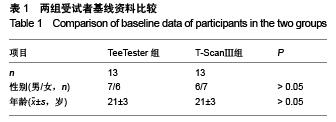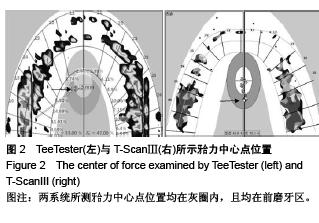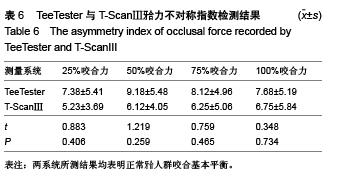| [1] 易新竹.牙合学[M].3版.北京:人民卫生出版社,2012:6-33.
[2] Gümü? HÖ, K?l?nç H?, Tuna SH, et al.. Computerized analysis of occlusal contacts in bruxism patients treated with occlusal splint therapy. J Adv Prosthodont.2013; 5(3): 256-61.
[3] 华咏梅,牟福元,金蕾.正常牙合者咬合功能的研究[J].现代口腔医学杂志,2007,21(5):468-470.
[4] 安薇薇,王邦康,白玉兴.T-ScanⅡ咬合分析记录仪结果可重复性的临床评价[J].北京口腔医学,2006,14(2):112-115.
[5] Makofsky HW. The influence of forward head posture on dental occlusion. Cranio. 2000,18(1):30-39.
[6] Liu CW,Chang YM,Shen YF,et al. Using the T-scan III system to analyze occlusal function in mandibular reconstruction patients:Apilot study. Biomed J.2015;38(1):52-57.
[7] Wang C, Yin XM. Occlusal risk factors associated with temporomandibular disorders in young adults with normal occlusions. Oral Surg Oral Med Oral Pathol Oral Radiol. 2012; 114(4):419-423.
[8] 王旭,杨晓东,艾红军.咬合力测试仪辅助治疗8例冠修复后颞下颌关节紊乱病临床分析[J].山西医药杂志,2014,18(2):163-164.
[9] 于婷婷,宋光保.T-Scan系统的特点及临床应用[J].国际口腔医学杂志,2013,40(1):113-116.
[10] 张燕,李红彩,宁静,等.固定义齿修复以牙槽骨严重吸收牙作为基牙的临床研究[J].牙体牙髓牙周病学杂志,2013,23(2):121-124.
[11] Satheesh BH. Digital Evaluation of Functional Occlusion Parameters and their Association with Temporomandibular Disorders. J Clin Diagn Res. 2013;7(8):1772-1775.
[12] Trpevska V, Kovacevska G, Benedeti A, et al. T-scan III system diagnostic tool for digital occlusal analysis in orthodontics - a modern approach. Prilozi. 2014;35(2): 155-60.
[13] Ma FF, Hu XL, Li JH, et al. Normal occlusion study:using T-Scan III occlusal analysis system. Chinese Journal of Stomatology. 2013;48(6): 363-7.
[14] Cotru ??AM, Mih?escu CS, T?n?sescu LA, et al. Analyzing the morphology and intensity of occlusal contacts in implant-prosthetic restorations using T-Scan dsystem. Rom J Morphol Embryol. 2015,56(1):277-81.
[15] 黄大海,丁仲鹃.T-ScanⅢ数字化咬合分析系统临床应用进展[J].中国实用口腔医学杂志,2011,4(3):181-183.
[16] Kerstein RB, Thumati P, Padmaja S. Force Finishing and Centering to Balance Removable Complete Denture Prosthesis Using the T-Scan III Computerized Occlusal Analysis System. J Indian Prosthodont Soc, 2013, 13(3): 184-8.
[17] Cerna M, Ferreira R, Zaror C, et al. Validity and reliability of the T-ScanIII for measuring force under laboratory conditions. J Oral Rehabil. 2015; 42(7): 544-51.
[18] 程慧娟,耿屹,张富强.正常牙合牙尖交错位咬合的T-ScanⅡ系统分析[J].上海口腔医学,2012,21(1):62-65.
[19] 胡志刚,程辉,郑明,等.正常牙合牙尖交错位咬合平衡的定量研究[J].中华口腔医学杂志,2006,41(10):618-620.
[20] Yamada K, Hanada K, Sultana MH. The relationship between frontal facial morphdogy and occlusal force In orthodontic patients with temporomanderdisorder. J Oral Rehabil.2000; 27(5):413-421.
[21] 皮晰.口腔解剖生理学[M].6版.北京:人民卫生出版社,2007: 293-294.
|

.jpg)


.jpg)
.jpg)
.jpg)

.jpg)